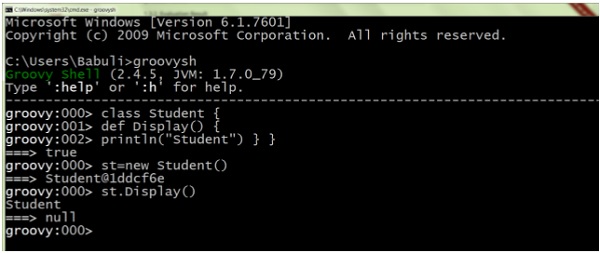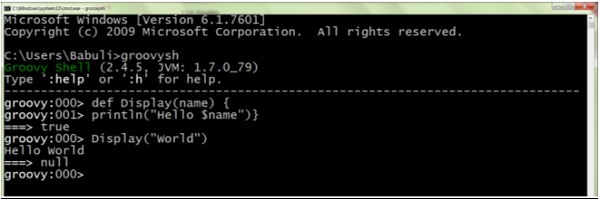
- Groovy Tutorial
- Groovy - Home
- Groovy - Overview
- Groovy - Environment
- Groovy - Basic Syntax
- Groovy - Data Types
- Groovy - Variables
- Groovy - Optionals
- Groovy - Numbers
- Groovy - Strings
- Groovy - Ranges
- Groovy - Lists
- Groovy - Maps
- Groovy - Dates & Times
Groovy Operators
- Groovy - Operators
- Groovy - Arithmetic Operators
- Groovy - Assignment Operators
- Groovy - Relational Operators
- Groovy - Logical Operators
- Groovy - Bitwise Operators
- Groovy - Spaceship Operator
- Groovy - in Operator
- Groovy - Elvis Operator
- Groovy - Safe Navigation Operator
- Groovy Operator Precedence & Associativity
Control Statements
- Groovy - Decision Making
- Groovy - If Else Statement
- Groovy - Switch Statement
- Groovy - Loops
- Groovy - For Loop
- Groovy - For-in Loop
- Groovy - While Loop
- Groovy - Do While Loop
- Groovy - Break Statement
- Groovy - Continue Statement
Groovy File Handling
- Groovy - File I/O
- Java - Create a File
- Java - Write to File
- Java - Append to File
- Java - Read Files
- Java - Delete Files
- Java - File Properties
- Java - File Existence and Type
- Java - File Size
- Java - File Permissions
- Java - Directories
- Java - Listing Directories
- Java - Filtering Files/Directories
- Java - Deleting Directories
- Java - Renaming Files/Directories
Groovy Error & Exceptions
- Groovy - Exception Handling
- Groovy - try-catch Block
- Groovy - try-with-resources
- Groovy - Multi-catch Block
- Groovy - Nested try Block
- Groovy - Finally Block
- Groovy - throw Exception
- Groovy - Exception Propagation
- Groovy - Built-in Exceptions
- Groovy - Custom Exception
Groovy Multithreading
- groovy - Multithreading
- groovy - Thread Life Cycle
- groovy - Creating a Thread
- groovy - Starting a Thread
- groovy - Joining Threads
- groovy - Naming Thread
- groovy - Thread Scheduler
- groovy - Thread Pools
- groovy - Main Thread
- groovy - Thread Priority
- groovy - Daemon Threads
- groovy - Shutdown Hook
Groovy Synchronization
- groovy - Synchronization
- groovy - Block Synchronization
- groovy - Static Synchronization
- groovy - Inter-thread Communication
- groovy - Thread Deadlock
- groovy - Interrupting a Thread
- groovy - Thread Control
- groovy - Reentrant Monitor
- Groovy - Methods
- Groovy - Methods
- Groovy - Optional parenthesis
- Groovy - Named Arguments
- Groovy - Closures as Arguments
- Groovy - Method Overloading
- Groovy - Method Scope and Visibility
- Groovy - isCase Method
- Groovy - Implicit Return
- Groovy - Variable Arguments
- Groovy - Regular Expressions
- Groovy - Regular Expressions
- Groovy - Defining Regular Expressions
- Groovy - Matcher Object
- Groovy - Regex Tasks
- Groovy - XML
- Groovy - XML
- Groovy - Parsing XML
- Groovy - Creating XML
- Groovy - Modifying XML
- Groovy - Querying XML
- Groovy - Simplified Notation
- Groovy - Closure based Querying
- Groovy - Closure based Creation
- Groovy - JSON
- Groovy - JSON
- Groovy - Parsing JSON
- Groovy - Creating JSON using JsonOutput
- Groovy - Creating JSON using JsonBuilder
- Groovy - Modifying JSON
- Groovy - Error Handling
- Groovy - Handling JSON Arrays
- Groovy - JSON Array Operations
- Groovy - JSON Objects
- Groovy - JSON Object Operations
- Groovy - Generics
- Groovy - Generics
- Groovy - Declaring Generic Types
- Groovy - Bound Type Parameters
- Groovy - Wild Cards
- Groovy - Miscellaneous
- Groovy - Object Oriented
- Groovy - Closures
- Groovy - Annotations
- Groovy - JMX
- Groovy - DSLS
- Groovy - Database
- Groovy - Builders
- Groovy - Command Line
- Groovy - Unit Testing
- Groovy - Template Engines
- Groovy - Meta Object Programming
- Groovy Useful Resources
- Groovy - Quick Guide
- Groovy - Useful Resources
- Groovy - Discussion
Groovy - Command Line
The Groovy shell known as groovysh can be easily used to evaluate groovy expressions, define classes and run simple programs. The command line shell gets installed when Groovy is installed.
Following are the command line options available in Groovy −
| Command line parameter | Full Name | Details |
|---|---|---|
| -C | --color[=FLAG] | Enable or disable use of ANSI colors |
| -D | --define=NAME=VALUE | Define a system property |
| -T | --terminal=TYPE | Specify the terminal TYPE to use |
| -V | --version | Display the version |
| -classpath | Specify where to find the class files must be the first argument | |
| -cp | --classpath | Aliases for '-classpath' |
| -d | --debug | --debug Enable debug output |
| -e | --evaluate=arg | Evaluate option fist when starting interactive session |
| -h | --help | Display this help message |
| -q | --quiet | Suppress superfluous output |
| -v | --verbose | Enable verbose output |
The following snapshot shows a simple example of an expression being executed in the Groovy shell. In the following example we are just printing Hello World in the groovy shell.

Classes and Functions
It is very easy to define a class in the command prompt, create a new object and invoke a method on the class. The following example shows how this can be implemented. In the following example, we are creating a simple Student class with a simple method. In the command prompt itself, we are creating an object of the class and calling the Display method.

It is very easy to define a method in the command prompt and invoke the method. Note that the method is defined using the def type. Also note that we have included a parameter called name which then gets substituted with the actual value when the Display method is called. The following example shows how this can be implemented.

Commands
The shell has a number of different commands, which provide rich access to the shells environment. Following is the list of them and what they do.
| Sr.No | Command &smp; Command Description |
|---|---|
| 1 |
:help (:h ) Display this help message |
| 2 |
? (:? ) Alias to: :help |
| 3 |
:exit (:x ) Exit the shell |
| 4 |
:quit (:q ) Alias to: :exit |
| 5 |
import (:i ) Import a class into the namespace |
| 6 |
:display (:d ) Display the current buffer |
| 7 |
:clear (:c ) Clear the buffer and reset the prompt counter |
| 8 |
:show (:S ) Show variables, classes or imports |
| 9 |
:inspect (:n ) Inspect a variable or the last result with the GUI object browser |
| 10 |
:purge (:p ) Purge variables, classes, imports or preferences |
| 11 |
:edit (:e ) Edit the current buffer |
| 12 |
:load (:l ) Load a file or URL into the buffer |
| 13 |
. (:. ) Alias to: :load |
| 14 |
.save (:s ) Save the current buffer to a file |
| 15 |
.record (:r ) Record the current session to a file |
| 16 |
:alias (:a ) Create an alias |
| 17 |
:set (:= ) Set (or list) preferences |
| 18 |
:register (:rc) Registers a new command with the shell |
| 19 |
:doc (:D ) Opens a browser window displaying the doc for the argument |
| 20 |
:history (:H ) Display, manage and recall edit-line history |